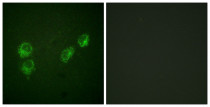ARG66708
anti-PLN / Phospholamban phospho (Ser16/Thr17) antibody
anti-PLN / Phospholamban phospho (Ser16/Thr17) antibody for ICC/IF and Human
Overview
| Product Description | Rabbit Polyclonal antibody recognizes PLN / Phospholamban phospho (Ser16/Thr17) |
|---|---|
| Tested Reactivity | Hu |
| Tested Application | ICC/IF |
| Host | Rabbit |
| Clonality | Polyclonal |
| Isotype | IgG |
| Target Name | PLN / Phospholamban |
| Antigen Species | Human |
| Immunogen | Phosphospecific peptide around Ser16/Thr17 of Human PLN. |
| Conjugation | Un-conjugated |
| Alternate Names | CMH18; PLB; CMD1P; Cardiac phospholamban |
Application Instructions
| Application Suggestion |
|
||||
|---|---|---|---|---|---|
| Application Note | * The dilutions indicate recommended starting dilutions and the optimal dilutions or concentrations should be determined by the scientist. |
Properties
| Form | Liquid |
|---|---|
| Purification | Affinity purification with immunogen. |
| Buffer | PBS, 0.02% Sodium azide, 50% Glycerol and 0.5% BSA. |
| Preservative | 0.02% Sodium azide |
| Stabilizer | 50% Glycerol and 0.5% BSA |
| Concentration | 1 mg/ml |
| Storage Instruction | For continuous use, store undiluted antibody at 2-8°C for up to a week. For long-term storage, aliquot and store at -20°C. Storage in frost free freezers is not recommended. Avoid repeated freeze/thaw cycles. Suggest spin the vial prior to opening. The antibody solution should be gently mixed before use. |
| Note | For laboratory research only, not for drug, diagnostic or other use. |
Bioinformation
| Database Links | |
|---|---|
| Gene Symbol | PLN |
| Gene Full Name | phospholamban |
| Background | The protein encoded by this gene is found as a pentamer and is a major substrate for the cAMP-dependent protein kinase in cardiac muscle. The encoded protein is an inhibitor of cardiac muscle sarcoplasmic reticulum Ca(2+)-ATPase in the unphosphorylated state, but inhibition is relieved upon phosphorylation of the protein. The subsequent activation of the Ca(2+) pump leads to enhanced muscle relaxation rates, thereby contributing to the inotropic response elicited in heart by beta-agonists. The encoded protein is a key regulator of cardiac diastolic function. Mutations in this gene are a cause of inherited human dilated cardiomyopathy with refractory congestive heart failure. [provided by RefSeq, Jul 2008] |
| Function | Reversibly inhibits the activity of ATP2A2 in cardiac sarcoplasmic reticulum by decreasing the apparent affinity of the ATPase for Ca(2+). Modulates the contractility of the heart muscle in response to physiological stimuli via its effects on ATP2A2. Modulates calcium re-uptake during muscle relaxation and plays an important role in calcium homeostasis in the heart muscle. The degree of ATP2A2 inhibition depends on the oligomeric state of PLN. ATP2A2 inhibition is alleviated by PLN phosphorylation. [UniProt] |
| Cellular Localization | Endoplasmic reticulum membrane; Single-pass membrane protein. Sarcoplasmic reticulum membrane; Single-pass membrane protein. Mitochondrion membrane; Single-pass membrane protein. Membrane; Single-pass membrane protein. Note=Colocalizes with HAX1 at the endoplasmic reticulum (PubMed:17241641). Colocalizes with DMPK a the sarcoplasmic reticulum (PubMed:15598648). [UniProt] |
| Calculated MW | 6 kDa |
| PTM | Phosphorylation by PKA abolishes the inhibition of ATP2A2-mediated calcium uptake. Phosphorylated at Thr-17 by CaMK2, and in response to beta-adrenergic stimulation. Phosphorylation by DMPK may stimulate sarcoplasmic reticulum calcium uptake in cardiomyocytes. [UniProt] |
Images (1) Click the Picture to Zoom In






